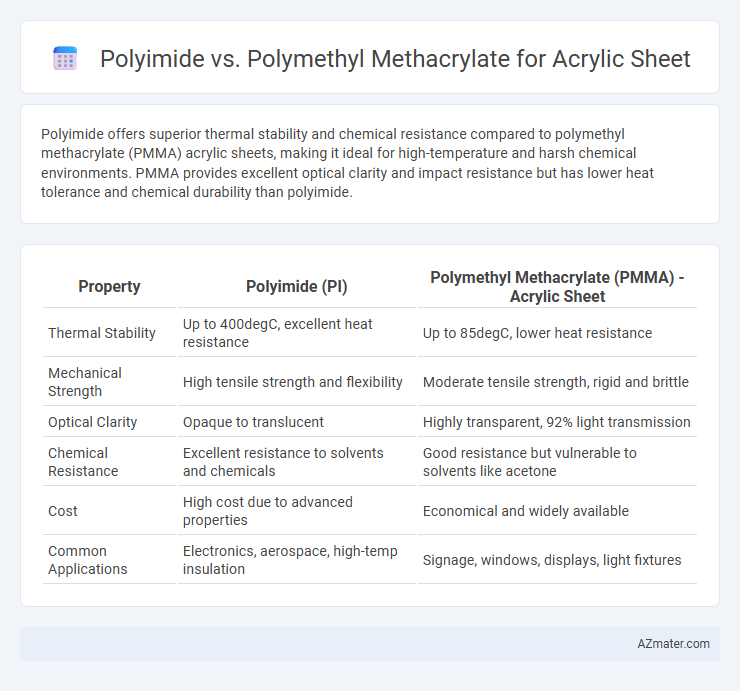Polyimide offers superior thermal stability and chemical resistance compared to polymethyl methacrylate (PMMA) acrylic sheets, making it ideal for high-temperature and harsh chemical environments. PMMA provides excellent optical clarity and impact resistance but has lower heat tolerance and chemical durability than polyimide.
Table of Comparison
| Property | Polyimide (PI) | Polymethyl Methacrylate (PMMA) - Acrylic Sheet |
|---|---|---|
| Thermal Stability | Up to 400degC, excellent heat resistance | Up to 85degC, lower heat resistance |
| Mechanical Strength | High tensile strength and flexibility | Moderate tensile strength, rigid and brittle |
| Optical Clarity | Opaque to translucent | Highly transparent, 92% light transmission |
| Chemical Resistance | Excellent resistance to solvents and chemicals | Good resistance but vulnerable to solvents like acetone |
| Cost | High cost due to advanced properties | Economical and widely available |
| Common Applications | Electronics, aerospace, high-temp insulation | Signage, windows, displays, light fixtures |
Introduction to Polyimide and Polymethyl Methacrylate (PMMA)
Polyimide is a high-performance polymer known for its exceptional thermal stability, chemical resistance, and mechanical strength, making it ideal for demanding industrial applications. Polymethyl Methacrylate (PMMA), commonly referred to as acrylic, is a transparent thermoplastic favored for its optical clarity, lightweight nature, and weather resistance, often used in displays and glazing. Both materials serve distinct roles in acrylic sheet production, with Polyimide excelling in durability and high-temperature environments, while PMMA offers superior transparency and ease of fabrication.
Chemical Structures and Composition
Polyimide exhibits a complex aromatic imide backbone providing exceptional thermal stability and chemical resistance, characterized by repeating units of imide groups formed from dianhydrides and diamines. Polymethyl Methacrylate (PMMA), composed of linear chains of methyl methacrylate monomers with ester functional groups, offers high clarity and UV resistance but lower thermal endurance compared to polyimide. The distinct chemical structures influence their performance in acrylic sheets, with polyimide suited for high-temperature applications and PMMA favored for optical clarity and weatherability.
Thermal Stability Comparison
Polyimide exhibits superior thermal stability compared to polymethyl methacrylate (PMMA), maintaining its structural integrity at temperatures exceeding 400degC, whereas PMMA typically degrades around 150degC to 200degC. The high glass transition temperature (Tg) of polyimide, often above 350degC, enables its use in high-temperature applications where acrylic sheets made from PMMA would soften or deform. Polyimide's resistance to thermal oxidation and its capacity to withstand repeated thermal cycling make it ideal for demanding environments requiring consistent performance under extreme heat.
Mechanical Properties: Strength and Flexibility
Polyimide exhibits superior mechanical properties compared to Polymethyl Methacrylate (PMMA), offering exceptional tensile strength and high thermal stability, which makes it ideal for demanding engineering applications. While PMMA, commonly called acrylic, provides moderate strength and excellent optical clarity, its flexibility is limited, causing brittleness under impact stress. Polyimide's ability to maintain flexibility at elevated temperatures contrasts with PMMA's rigidity, making polyimide sheets more durable for dynamic mechanical environments.
Optical Clarity and Light Transmission
Polyimide offers exceptional thermal stability but exhibits lower optical clarity and light transmission compared to Polymethyl Methacrylate (PMMA), which is widely recognized for its superior transparency and high light transmittance exceeding 90%. PMMA acrylic sheets maintain excellent optical clarity with minimal color distortion, making them ideal for applications requiring clear visibility and bright light passage. In contrast, polyimide's amber tint and reduced transparency limit its use in optical applications where maximum clarity is essential.
Chemical Resistance and Durability
Polyimide exhibits superior chemical resistance compared to Polymethyl Methacrylate (PMMA), effectively withstanding aggressive solvents, acids, and high temperatures without degradation. PMMA offers good optical clarity and moderate chemical resistance but is more susceptible to cracking and surface damage from alkaline substances and UV exposure. For demanding applications requiring exceptional durability and long-term chemical stability, polyimide acrylic sheets outperform PMMA variants.
Ease of Fabrication and Processing
Polyimide offers superior thermal stability and chemical resistance but requires specialized high-temperature processing equipment, making its fabrication more complex and costly compared to polymethyl methacrylate (PMMA). Polymethyl methacrylate excels in ease of fabrication, allowing for straightforward cutting, shaping, and thermoforming using conventional tools and lower processing temperatures. PMMA's accessibility and compatibility with standard manufacturing processes make it the preferred choice for applications prioritizing cost-effective and flexible production methods over the advanced properties of polyimide.
Cost Efficiency and Availability
Polyimide offers superior thermal stability and chemical resistance compared to polymethyl methacrylate (PMMA), but it is significantly more expensive and less readily available in acrylic sheet form. PMMA is widely accessible and cost-efficient, making it the preferred choice for applications requiring transparency and moderate durability at a lower price point. Manufacturers often select PMMA for budget-sensitive projects, while polyimide is reserved for specialized environments demanding high-performance material properties.
Typical Applications in Industry
Polyimide excels in high-temperature electronics, aerospace insulation, and flexible printed circuits due to its exceptional thermal stability and mechanical strength. Polymethyl Methacrylate (PMMA), commonly known as acrylic, is favored in automotive lighting, signage, and optical lenses for its clarity, weather resistance, and ease of fabrication. Industries select Polyimide for demanding environments requiring durability under heat, whereas PMMA is preferred for transparent, lightweight, and decorative applications.
Choosing the Best Material for Acrylic Sheet Needs
Polyimide offers superior thermal stability and chemical resistance compared to polymethyl methacrylate (PMMA), making it ideal for high-temperature or harsh environment applications. PMMA acrylic sheets provide excellent optical clarity and UV resistance, suitable for decorative or light-transmitting uses. Selecting between polyimide and PMMA depends on specific requirements such as heat tolerance, mechanical strength, and clarity demands of the acrylic sheet application.

Infographic: Polyimide vs Polymethyl Methacrylate for Acrylic Sheet
 azmater.com
azmater.com